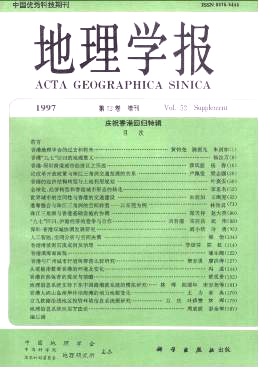Tong Guobang, Yang Xiangdong, Wang Sumin,Chong Zhuying, Xia Lianghua
According to the sporo pollen data of surface samples from Manzheli to Dayangshu, northern of northeast of China, we apply methods of systomolustor, corrosponding analysis, diffcrcntiatic grado (Hs) and isostatic gradc(E), and discuss the polynoflora abundance, species variety and equitability of Zhalainor. It indicates that the ecotype underwent ten ecological periods which belongs to three stages in the region over the past 13.0kaB.P.: (1) Sylvosteppe stage (10.2—2.9kaB.P.), including steppe mixed coniferous forest (3.2—2.9kaB.P.); steppe scattled pinus, Cupressaceae (5.6—3.2kaB.P.); steppe scattled birch, Quercus and other deciduous trees (6.8—5.6kaB.P.); steppe with birch (7.1—6.8kaB.P.); steppe scattled Pinus, Cupressaceae (10.2—7.1kaB.P.). (2) Steppe and tundra stage (12.9—10.2kaB.P.), including bushland with Betula(10.3—10.2kaB.P.); bushland with Betula and Picea (10.6—10.3kaB.P.); tundra with Betula (10.9—10.6kaB.P.); bushland seattled Bctula, Pieea (12.9—10.9kaB.P.). (3) Tundra (20.0—12.9kaB.P.), inciuding only one ecotype which was bushtundra. In the first phase, the content of trees pollen (mainly conifers such as Pinus, Cupressaceae) was 30%—60%, and sometimes that of deciduous trees (mainly Betula, Quercus, Ulmus) was close to of confers. The type of herbs (mainly Compositac and gramincac) was abundancc, but dryresistant and haloxene plant (Chenopodiaceae) rose relatively at some individual strata. The sporo pollen concentration was 350—5642grains/g, the values of Hs (1.6—2.4)and E (0.3—0.6) were more than those of steppe ceotype, indicating the abundant plant species and quantity. In the second phase, it was occupied by pollen of herbs (80%) which was mainly Artemisia and Chenopodiaceae, and the sporo pollen conccntration was 200—6400 grains/g, Hs and E were 1.4—2.4and 0.2—0.6 respectively. The upper limit of all the values was lower than that of sylvosteppe, indicating the lower species abundance and differentiatic grade of steppe. The ecotype of tundra with Betula appeared in particular layers. In the third phase, the value of herbs and ferns sporo pollen was more than 90%, and that of trees pollen was very low (less than 5%). There were mainly Artemisia, Compositae and Gramineae in herbs, Botrychium in ferns and only a small amount of Betula nana and Picea in shurbs and trees. The sporo pollen concentration was 200—700 grains/g, the values of Hs (1.1—2.2) and E (0.3—0.4) were the lowest in the profile, indicating that the vegetation was rare and monotonous, and the ecotype was in the more miserable condition. In the postglacial period, the range and the oscillation of climate were greatly and frequently, the ecotype alternated between bush steppe and tundra with Betula. The climate and environment in this region can be compared with that of the northern Europe. The environmental change in Holocene was mainly influenced by humidity, in the arid period, the ratio of chenopodiaceae of Artemisia added, while the sporo pollen concentration. Hs and E declined and reduced, and vice versa.
